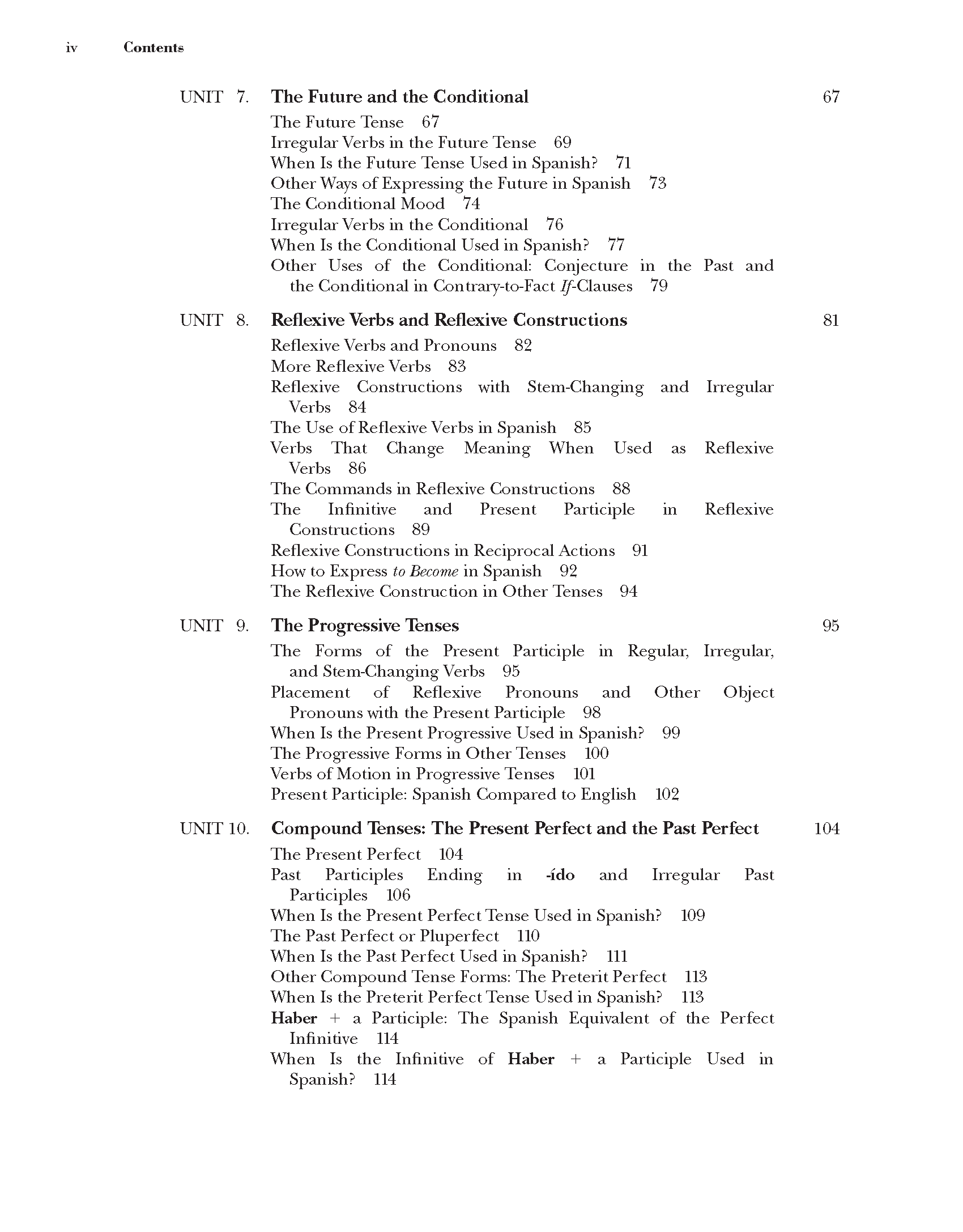CSG005

IV
Contents
UNIT 7.
UNIT 8.
UNIT 9.
UNIT 10.
The Futurę and the Conditional 67
The Futurę Tense 67 Irregular Yerbs in the Futurę Tense 69 When Is the Futurę Tense Used in Spanish? 7l Other Ways of Expressing the Futurę in Spanish 78 The Conditional Mood 74 Irregular Yerbs in the Conditional 76 When Is the Conditional Used in Spanish? 77 Other Uses of the Conditional: Conjecture in the Past and the Conditional in Gon trary-to-Fac t ^6 Claus es 79
Reflexive Verbs and Reflexive Constructions
Reflexive Yerbs and Pronouns 82 Morę Reflexive Yerbs 86
Reflexive Constructions with Stem-Changing and Verbs 84
The Use of Reflexive Yerbs in Spanish 85 Yerbs That Change Meaning When Used as Verbs 86
The Gommands in Reflexive Constructions 88 The Infinitive and Present Participle in Constructions 89
Reflexive Constructions in Reciprocal Actions 91 How to Express to Become in Spanish 92 The Reflexive Gonstruction in Other Tenses 94
The Progressive Tenses 95
The Forms of the Present Participle in Regular, Irregular, and Stem-Changing Yerbs 95
Placement of Reflexive Pronouns and Other Object
Pronouns with the Present Participle 98 When Is the Present Progressive Used in Spanish? 99 The Progressive Forms in Other Tenses 100 Yerbs of Motion in Progressive Tenses 101 Present Participle: Spanish Gompared to English 102
Compound Tenses: The Present Perfect and the Past Perfect 104
The Present Perfect 104
Past Participles Ending in -ido and Irregular Past
Participles 106
When Is the Present Perfect Tense Used in Spanish? 109 The Past Perfect or Pluperfect 110 When Is the Past Perfect Used in Spanish? 111 Other Compound Tense Forms: The Preterit Perfect 118 When Is the Preterit Perfect Tense Used in Spanish? 118 Haber + a Participle: The Spanish Equivalent of the Perfect Infinitive 114
When Is the Infinitive of Haber + a Participle Used in Spanish? 114
Irregular
Reflexive
Reflexive
81
Wyszukiwarka
Podobne podstrony:
CSG007 VI Contents UNIT 16. The Commands 175 Formal or Polite Commands 176 Formal
skanowanie0041 (10) • The behaviour expected of the leamer on completion of unit o
ContentsRevision Unit Test A 4 Test B 6 Test A
cw0022 UNIT 10 ETHICSLANGUAGE WORK m Match these corwersation excerpts. Has Joe ever done . a) Tha
cw0024 UNIT 10 ETHICS UNIT 10 ETHICS mnm LANGUAGE WORK Tip We use whose in defining or non-defining
internet S 54 Unit 10 4 godz MY FUTURĘ two student talking espressions pcrmanent/icmporarylife W:
Up?at 3 Teacher s Book podrecznik nauczyciela plus odpowiedzi ,testy,klucz answer key Page 006 Conte
Answer key: Progress tests (A)UNIT 10 Grammar 1 1 is placed 2 ar
Image (138) V Spis ważniejszych skrótów UNIT 1*10)4111111 Nnmdów Zjednoczonych ds. Ochrony grodów
Unit 10: Globahsation - expressions with tum Unit 11: For better, for worse - idioms to do with rela
więcej podobnych podstron